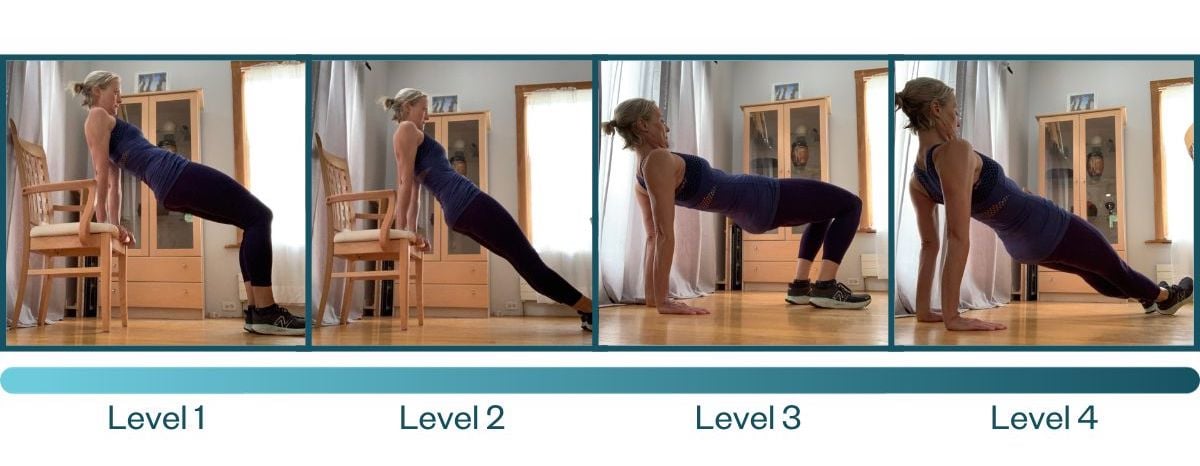DIASTASIS RECTI SERIES PART 3
Kim Raubenheimer is a certified Nutritionist and a trainer specializing in Diastasis Recti. After self-diagnosing her own diastasis in 2008, she went on a journey to discover everything she could about the condition. She continues to coach individuals - especially busy moms - and was eager to share her knowledge with Levelle Nutrition.
This is the third post in a 3-part series on Diastasis Recti.
![]()
For those with a diastasis, effective strengthening exercises - along with proper breathing and posture - can help bring the separated muscles closer together and help heal the connective tissue.
I used my body as a case study. After meeting with many experts, learning, studying, and getting more specialized certifications, I healed my own diastasis recti with exercise. Healing via exercise may not work for all, and sometimes, depending upon the severity of the diastasis, surgery can be required.
However, even surgery won’t fix incorrect movement patterns. Remember your foundations: keep focus on your breathing, posture and alignment as you perform any exercises.
Appropriate Exercise Modifications
Be careful to avoid any movement that puts force on the abdominal wall and increases intra-abdominal pressure. This includes any exercise or body position that bulges the abdominal muscles forward forcefully; causes coning or doming along the midline of the body; or exerts pain or downward pressure on the pelvic floor.
-
Avoid lifting both shoulders off the floor from a back-lying position. This means avoiding crunches, sit-ups, and variations of those exercises.
-
Avoid exercises that involve lifting both legs off the floor at the same time, such as double leg lifts and lowers.
-
Avoid thrusting the lower rib cage open. When the lower ribs splay apart, the upper abs follow. For example, stay away from full back bends or upward facing dog. Try poses with smaller ranges of motion that allow you to keep your ribs anchored in a neutral position.
-
Choose lower impact cardio. When you do jump or hop, think about exhaling from the bottom (pelvic floor up). As you exhale, the ribs knit together, the lower ribs move toward the hips and the belly draws toward the spine. If you feel any symptoms of pelvic pressure, vaginal heaviness, or leaking urine, then stop.
Strengthening Exercises
These are simple, effective exercises for strengthening the Transversus abdominis, which is critical for healing a diastasis recti. Start with Level 1. Progress forward as long as you can maintain your core and pelvis brace (with no arching) while utilizing your breath throughout the duration of the move.Thank you to Shirley Sarhmann for the heel slides and taps;
Prepare with your breath
Inhale, ribs expand. Exhale, ribs contract. Lower ribs move toward hips. Belly moves toward spine. Ribs don’t flare! Back does not arch. Brace your core, but make sure not to hold your breath.
Not sure how to practice a 360 breath? Check out the second post in our Diastasis Recti series: Tips to Rectify a Diastasis Recti.
Level 1
Heel slides:
In a supine position, place your feet on the floor. Prepare with your breath. Exhale as the foot moves away from your body, with you heel sliding on the floor. Think about keeping your pelvis stable as the foot moves. Inhale and reset. Switch feet.
Level 2
Reverse tabletop with 360 breathing:
Lie in a supine position. Prepare with your breath. Brace. Lift one leg to 90 degrees, then lift the other leg to 90 degrees. Just maintaining this position works your core. Below are four versions of reverse tabletop, from easiest (Level 1) to hardest (Level 4). Start with the easiest and progress from there. Alternatively, you can put your (clean) feet on a wall with your legs at a 90-degree angle. Practice 360 breathing while in this position.

Level 3
Heel taps – alternating heel:
Get into reverse tabletop position. Exhale as you move your heel toward the ground. Maintain a stable pelvis. If you find yourself arching your back, then don’t bring your heel all the way to the ground. Stop where you can maintain proper form. Exhale as you tap. Switch sides.
Challenge – Double heel taps:
Do not move to double heel taps unless you are able to tap a heel without arching and while keeping the pelvis stable.
Level 4
Dead bug:
You must be able to maintain a reverse tabletop without arching your back before performing this exercise. To set up your dead bug, prepare with your breath. Exhale and brace your core so you don't rock in your pelvis and arch your back. As your legs and arms move away you should be stable in your pelvis. Your belly should not bulge as you exhale. If you are not able to completely extend your leg, then tap your heel instead. As your arms and legs move away from your body, you must not arch your back.
Some Additional Tips:
Stop shallow breathing patterns.
- Use your abdominals to breathe in a 360 fashion.
- Move through your midline with everyday activities, which will help to connect and reinforce that fascial healing to improve diastasis.
- Think about alignment principles and apply them to movement including cardio.
Fix muscle imbalances.
- The greater the imbalance, the more likely a condition will arise. With internal oblique strength and weak external obliques, there seems to be a tendency for a diastasis. Learn how to strengthen your external obliques.
- Engage your abs! How? Each person is different.
- https://www.youtube.com/watch?v=9aZa86rSwR8
- Rib cage position matters!
Long-term Changes
Unfortunately, closing a diastasis does NOT guarantee it will stay closed. It requires whole-body life-changing behavior. You always have to be mindful as it is a weakness, similar to having a sprained ankle. I was able to get mine down to ½ finger in 4 months' time with posture/alignment changes and breathing while exercising, but when I am tired and not mindful of my breathing and form, I've pushed it in the opposite direction.
Fortunately, these whole body changes can not only help heal a diastasis, but can impact your entire body for the better. Daily and purposeful activities can lead to better posture, breathing, more strength and better movement. My hip and lower back ache went away! My posture is so much better! Don't suffer alone like I did. Please reach out with any questions.
![]()
![]()




